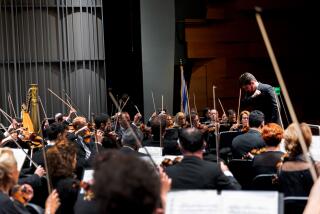WORLD MUSIC REVIEW : Hungarian Gipsy Orchestra Plays With Enthusiasm
- Share via
It’s unlikely that any of the members of Antal Szalai’s Hungarian Gipsy Orchestra have spent much time hanging around campfires lately. But the music the 12-piece ensemble brought to UCLA’s Schoenberg Hall Friday night was filled with redolent echoes of a tradition that reaches back to the 13th Century.
Much of the dynamic, upbeat program performed by Szalai’s players consisted of classically orchestrated Hungarian folk themes. The pieces varied widely--from Liszt’s dramatic “Hungarian Rhapsodies” to the gripping rhythms of the hora , the verbunkos and the czardas . And they underscored the fact that what is commonly thought of as Gypsy music is actually a Central European blending of rustic folk melodies and vigorous dance rhythms with traces of Middle Eastern scales and instrumental timbres.
The conservatory-trained orchestra (four violinists, two violists, a cellist, a bassist, two clarinetists, a flutist and a cembalon player) zipped through the sometimes difficult works with tremendous virtuosity and enthusiasm. Szalai is a superb violinist whose bravura technique contrasted with a lush instrumental tone encompassing melodramatic low notes and twittering high harmonics. Among the other artists, clarinetist Laszlo Feher was a standout, especially in a set of Kuruc songs in which he performed intensely theatrical variations on the tarogato --a rich-sounding, soprano saxophone-like woodwind instrument.
But the real high point of the evening was the collective playing of the entire orchestra. Like the best of the Count Basie bands, the Hungarian Gipsy Orchestra played with intuitive togetherness as it shifted rhythms, accelerated tempos, improvised energetically and generated an irresistible forward momentum. The overflow audience, responding enthusiastically to the music’s twists and turns, loved every minute.
More to Read
The biggest entertainment stories
Get our big stories about Hollywood, film, television, music, arts, culture and more right in your inbox as soon as they publish.
You may occasionally receive promotional content from the Los Angeles Times.










